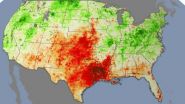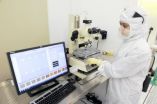(Press-News.org) WEST LAFAYETTE, Ind. – A new type of transistor shaped like a Christmas tree has arrived just in time for the holidays, but the prototype won't be nestled under the tree along with the other gifts.
"It's a preview of things to come in the semiconductor industry," said Peide "Peter" Ye, a professor of electrical and computer engineering at Purdue University.
Researchers from Purdue and Harvard universities created the transistor, which is made from a material that could replace silicon within a decade. Each transistor contains three tiny nanowires made not of silicon, like conventional transistors, but from a material called indium-gallium-arsenide. The three nanowires are progressively smaller, yielding a tapered cross section resembling a Christmas tree.
The research builds on previous work in which the team created a 3-D structure instead of conventional flat transistors. The approach could enable engineers to build faster, more compact and efficient integrated circuits and lighter laptops that generate less heat than today's.
New findings show how to improve the device performance by linking the transistors vertically in parallel.
"A one-story house can hold so many people, but more floors, more people, and it's the same thing with transistors," Ye said. "Stacking them results in more current and much faster operation for high-speed computing. This adds a whole new dimension, so I call them 4-D."
Findings will be detailed in two papers to be presented during the International Electron Devices Meeting on Dec. 8-12 in San Francisco. One of the papers has been highlighted by conference organizers as among "the most newsworthy topics and papers to be presented."
The work is led by Purdue doctoral student Jiangjiang Gu and Harvard postdoctoral researcher Xinwei Wang.
The newest generation of silicon computer chips, introduced this year, contain transistors having a vertical 3-D structure instead of a conventional flat design. However, because silicon has a limited "electron mobility" - how fast electrons flow - other materials will likely be needed soon to continue advancing transistors with this 3-D approach, Ye said.
Indium-gallium-arsenide is among several promising semiconductors being studied to replace silicon. Such semiconductors are called III-V materials because they combine elements from the third and fifth groups of the periodic table.
The authors of the research papers are Gu; Wang; Purdue doctoral student H. Wu; Purdue postdoctoral research associate J. Shao; Purdue doctoral student A. T. Neal; Michael J. Manfra, Purdue's William F. and Patty J. Miller Associate Professor of Physics; Roy Gordon, Harvard's Thomas D. Cabot Professor of Chemistry; and Ye.
Transistors contain critical components called gates, which enable the devices to switch on and off and to direct the flow of electrical current. Smaller gates make faster operation possible. In today's 3-D silicon transistors, the length of these gates is about 22 nanometers, or billionths of a meter.
The 3-D design is critical because gate lengths of 22 nanometers and smaller do not work well in a flat transistor architecture. Engineers are working to develop transistors that use even smaller gate lengths; 14 nanometers are expected by 2015, and 10 nanometers by 2018.
However, size reductions beyond 10 nanometers and additional performance improvements are likely not possible using silicon, meaning new materials will be needed to continue progress, Ye said.
Creating smaller transistors also will require finding a new type of insulating, or "dielectric" layer that allows the gate to switch off. As gate lengths shrink smaller than 14 nanometers, the dielectric used in conventional transistors fails to perform properly and is said to "leak" electrical charge when the transistor is turned off.
Nanowires in the new transistors are coated with a different type of composite insulator, a 4-nanometer-thick layer of lanthanum aluminate with an ultrathin, half-nanometer layer of aluminum oxide. The new ultrathin dielectric allowed researchers to create transistors made of indium-gallium- arsenide with 20-nanometer gates, which is a milestone, Ye said.
###
The work, based at the Birck Nanotechnology Center in Purdue's Discovery Park, is funded by the National Science Foundation and the Semiconductor Research Corp.
Writer: Emil Venere, 765-494-4709, venere@purdue.edu
Source: Peide Ye, 765-494-7611, yep@purdue.edu
Related websites:
Peide Ye: http://cobweb.ecn.purdue.edu/~yep/
International Electron Devices Meeting: http://www.his.com/~iedm/
Birck Nanotechnology Center: http://www.purdue.edu/discoverypark/nanotechnology/
New '4-D' transistor is preview of future computers
2012-12-06
ELSE PRESS RELEASES FROM THIS DATE:
NASA satellites analyze Typhoon Bopha inside and out
2012-12-06
Typhoon Bopha proved deadly to residents in the Mindanao region of the Philippines after ravaging islands in Micronesia. NASA's Aqua and TRMM satellites peered at the storm inside and out, providing forecasters with valuable data as the storm moved into the South China Sea.
On Dec. 5, 2012, Bopha crossed over Palawan and entered the South China Sea after crossing over the southern Philippines' Mindanao region, leaving death and destruction in its wake. According to Reuters news reports on Dec. 5, at least at total of 283 people were killed and hundreds remain missing ...
Plant stress paints early picture of drought
2012-12-06
In July 2012, farmers in the U.S. Midwest and Plains regions watched crops wilt and die after a stretch of unusually low precipitation and high temperatures. Before a lack of rain and record-breaking heat signaled a problem, however, scientists observed another indication of drought in data from NASA and NOAA satellites: plant stress.
Healthy vegetation requires a certain amount of water from the soil every day to stay alive, and when soil moisture falls below adequate levels, plants become stressed. Scientists with the U.S. Department of Agriculture's Agricultural Research ...
NASA investigates use of 'trailblazing' material for new sensors
2012-12-06
Tiny sensors -- made of a potentially trailblazing material just one atom thick and heralded as the "next best thing" since the invention of silicon -- are now being developed to detect trace elements in Earth's upper atmosphere and structural flaws in spacecraft.
Technologist Mahmooda Sultana, who joined NASA's Goddard Space Flight Center in Greenbelt, Md., two years ago and has since emerged as Goddard's go-to expert in the development of graphene-based technology, has expanded her portfolio to include two new research and development efforts aimed at creating nano-sized ...
Site-specific, long-term research expanding understanding of climate change
2012-12-06
DURHAM, N.H., Dec. 5, 2012 – While science has often focused on big-scale, global climate change research, a study recently published in the journal Bioscience suggests that long-term, integrated and site-specific research is needed to understand how climate change affects multiple components of ecosystem structure and function, sometimes in surprising ways.
"Long-term ecological research is important to understanding the effects of a changing climate on our natural resources and so much more," said Michael T. Rains, Director of the Forest Service's Northern Research Station. ...
Experts available to discuss new paper detailing global sea level rise scenario
2012-12-06
On December 6, NOAA will release a technical report that estimates global mean sea level rise over the next century based on a comprehensive synthesis of existing scientific literature. The report finds that there is very high confidence (greater than 90% chance) that global mean sea level will rise at least 8 inches (0.2 meters) and no more than 6.6 feet (2 meters) by 2100, depending upon uncertainties associated with ice sheet loss and ocean warming.
The actual amount of sea level change at any one region and location greatly varies in response to regional and local ...
Biologists unlocking the secrets of plant defenses, 1 piece at a time
2012-12-06
Researchers examining how the hormone jasmonate works to protect plants and promote their growth have revealed how a transcriptional repressor of the jasmonate signaling pathway makes its way into the nucleus of the plant cell.
They hope the recently published discovery will eventually help farmers experience better crop yields with less use of potentially harmful chemicals.
"This is a small piece of a bigger picture, but it is a very important piece," said Maeli Melotto, a University of Texas at Arlington assistant professor of biology.
Melotto recently co-authored ...
Military/Veteran Medical Malpractice Claims Are An Uphill Battle
2012-12-06
Military/Veteran medical malpractice claims are an uphill battle
Some of the highest courts in the land -- the United States Supreme Court among them -- will soon be hearing cases involving the niche area of military malpractice claims. Military physicians usually enjoy "sovereign immunity" (essentially making them immune from many types of lawsuits) in their capacity as physicians working for the government.
These cases do not argue the validity of sovereign immunity, but instead question its applicability in even the most egregious military medical malpractice ...
Could Patient Photos Reduce Serious Medical Errors?
2012-12-06
Could patient photos reduce serious medical errors?
A study by researchers at a Colorado hospital found that including photos in patients' electronic medical records helps reduce serious medical mistakes known as "wrong-patient errors." Implementing electronic record systems with photos at hospitals across the country may help improve the national rate of serious medical errors.
Researchers find using a photo drastically reduces number of errors
In 2009, Children's Hospital Colorado found that misplaced orders in electronic files was the second-most common ...
Potential Pitfalls When Keeping The Home After Divorce
2012-12-06
Potential pitfalls when keeping the home after divorce
One of the most common disagreements among divorcing couples, along with issues of child custody and alimony, is who gets to keep the house. While it is perfectly understandable to be reluctant to give up one's home, people going through divorce should be aware of some hidden costs they may not be expecting if they decide to keep the house.
Maintenance and repair costs
One common unexpected pitfall occurs when the spouse who keeps the home has not accurately estimated the monthly expenses involved in maintaining ...
How Will Divorce Affect My Business In Colorado?
2012-12-06
How will divorce affect my business in Colorado?
For many people going through a divorce, one of the most difficult steps in the divorce process is dividing up shared property such as the family home, vehicles, savings accounts and other valuables. When one or both spouses are business owners, the property division process can become even more complicated and potentially volatile. Business owners in Colorado should be aware of how their business assets may be treated in the event of divorce and take steps to protect them in case such a situation should arise.
Division ...


